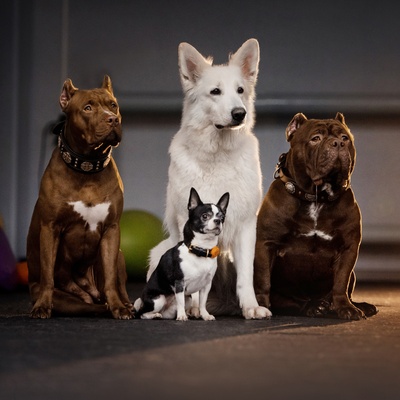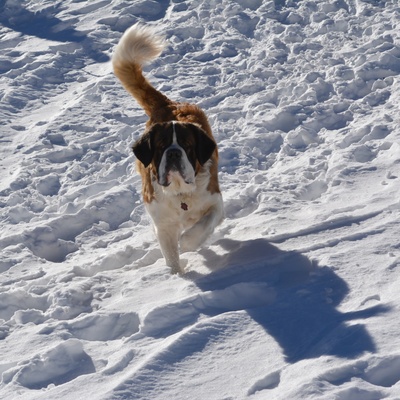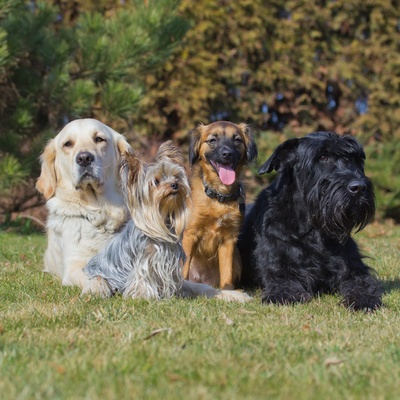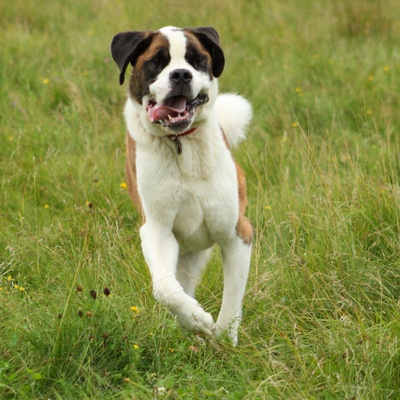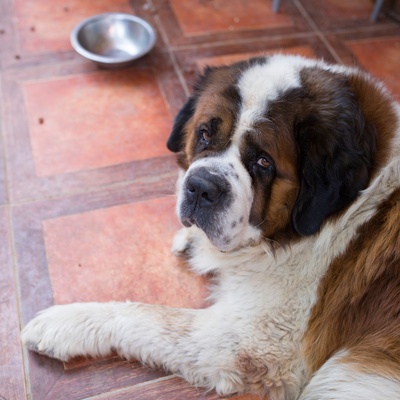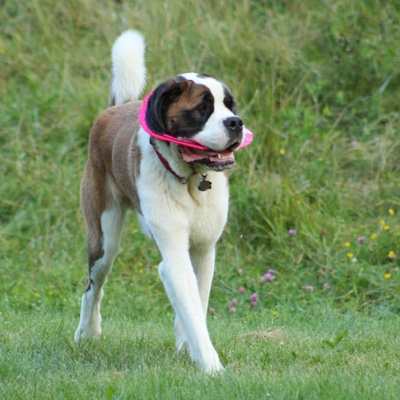Introducing the Saint Bernard
Discover all there is to know about the Saint Bernard : its characteristics, behavior, training, and its cost.

Discover all there is to know about the Saint Bernard : its characteristics, behavior, training, and its cost.
Originating from the Swiss Alps, the Saint Bernard is a breed with a noble and storied history, primarily recognized for its role in mountain rescue. These dogs are among the most adored and popular giants worldwide, known for their remarkable bravery and unparalleled aptitude in rescue missions.
Their nature is affectionate and loyal; they are dogs that embody the essence of companionship and dedication. With their immense size comes an equally large heart; Saint Bernards are sociable creatures, displaying their love and affection in grand, demonstrative ways. Whether saving lives in the snowy Alps or providing comfort at home, the Saint Bernard is a breed that leaves a lasting impression on all who encounter them.
This section outlines the unique features of the Saint Bernard breed.
Saint Bernards belong to the working group (2), celebrated for their rescue abilities and gentle nature. These dogs excel in tasks requiring strength and intelligence.
This giant breed stands 26 to 30 inches tall, weighing 120 to 180 pounds, with some males exceeding 200 pounds.
They feature short and long coat varieties, both providing cold weather insulation.
Their coats are primarily white with red, brownish-yellow, or brindle markings, especially on the face and back.
Saint Bernards adapt well to family environments, thriving in homes with space to roam.
They are known for their gentle disposition, great with children, and friendly towards other animals.
While generally healthy, they're prone to hip and elbow dysplasia, and cardiac issues, necessitating regular veterinary care.
These dogs are intelligent but require patient, consistent training from an early age, responding best to positive reinforcement.
We can help!
Every dog has its own character, and so do you. Making the right choice will ensure his well-being and yours.
Take our quiz to find out which breed is right for you, based on your personality, lifestyle, location and many other criteria.
Don't wait any longer and take the quiz to find out the answer!
The Saint Bernard stands as a towering figure of strength, balanced elegantly with a gentle demeanor. Their dense, predominantly white coat with contrasting red, brown, or brindle markings, and their expressive faces, marked by deep, kind eyes and a jowly smile, make them unmistakable.
Saint Bernards are among the largest dog breeds, with females standing between 24 to 26 inches and males reaching 26 to 30 inches. In terms of weight, females typically range from 120 to 140 pounds, while males can weigh anywhere from 140 to 180 pounds.
Saint Bernards experience a rapid growth rate, quickly reaching significant milestones within their first year. By the age of 2, they generally achieve their full size and weight, embodying the majestic stature for which they are known.
The Saint Bernard boasts a magnificent double coat that comes in two varieties: short and long. The short-haired, or smooth coat, features dense, tough fur, while the long-haired variety is adorned with a longer, slightly wavy outer coat and a dense undercoat.
The color palette of the Saint Bernard's coat typically includes shades of red with white, or a predominantly white coat with red, brown, mahogany, or brindle markings. The face often features a distinctive "mask" that adds to their expressive appearance.
The Saint Bernard is the epitome of balance and proportion, embodying strength and gentleness in its stature. The breed's head is massive and imposing, with a broad skull and a short, deep muzzle; their expression is one of intelligence and kindness. Their eyes, set somewhat deep, are of a dark brown hue, conveying a gentle and friendly demeanor.
The ears, medium in size and set high on the head, hang close to the cheeks, contributing to their amiable expression. The body of a Saint Bernard is muscular and powerful, with a broad chest and strong, well-built limbs, reflecting their capability to navigate through challenging terrains. This majestic breed combines robustness with agility, capable of swift movement despite its size.
The Saint Bernard is renowned for its profound loyalty, immense capacity for affection, and an instinctive sense of protection, making it a gentle, patient, and reliable family companion.
Among the over 400 recognized dog breeds divided into 10 groups, the Saint Bernard falls within the working group (2). This category includes breeds like the Bernese Mountain Dog, or Boxer, known for their strength, intelligence, and versatility in tasks such as rescue, sled pulling, and guarding. These dogs are celebrated for their work ethic, bravery, and loyalty, with a natural inclination towards safeguarding and assisting humans.
Saint Bernards are especially notable for their rescue instincts, intelligence, and gentle yet alert demeanor, historically excelling as alpine rescue dogs. Their remarkable abilities in challenging conditions highlight their status not just as pets, but as heroes.
Saint Bernards are epitomized by their calm and patient demeanor, making them a serene presence in any home. They exhibit a profound level of affection and loyalty towards their owners, often showing their love through gentle leans and seeking physical closeness.
For a Saint Bernard to flourish, it requires an owner who is consistently present and engaged, providing the emotional support and attention necessary for their well-being. Despite their size, they have a tender nature and appreciate respectful acknowledgment of their independence.
Known for their sociability and inherent kindness, Saint Bernards extend a warm welcome to humans and animals alike. They are exceptionally good with children, displaying patience and a protective instinct that make them excellent family pets. Their generous spirit ensures they are friendly, even with strangers, making them poor guard dogs but wonderful companions.
Early socialization is crucial for Saint Bernards to develop well-rounded social skills, ensuring they grow into well-behaved and adaptable adults. Encouraging positive interactions from a young age reinforces their natural inclination towards friendliness and helps them navigate various social situations with ease.
Take the test and find out the dog breed that matches your personality and lifestyle.
The Saint Bernard is remarkably adaptable to various living environments, thriving equally in apartments or larger homes, and in both urban and rural settings. The key to their happiness isn't the size of the space but the quality of the attention and love they receive from their owners.
Saint Bernards form strong bonds with their families and tend to stay close by, embodying the term "gentle giant" in every sense. For their physical and mental well-being, it's recommended they are taken on walks twice a day, each lasting at least 30 minutes, to ensure they remain healthy and content.
Despite their adaptability, Saint Bernards greatly benefit from having access to outdoor spaces where they can explore and expend their energy. These dogs possess a curious nature and appreciate the freedom to roam and play in a secure area.
A yard or garden where they can relax and enjoy the fresh air, especially in cooler climates, makes for an ideal living arrangement for these affectionate giants.
The Saint Bernard is renowned not only for its size but also for its keen intelligence and willingness to learn. This breed demonstrates an impressive capacity for understanding and following commands, making them relatively straightforward to train with the right approach.
Training should emphasize positive reinforcement and patience, catering to their sensitive nature. Given their history as rescue dogs, Saint Bernards can be trained for a variety of tasks and respond well to challenges. Equipping them with a GPS collar is a prudent measure, ensuring their safety by preventing losses or escapes, especially in outdoor settings.
Saint Bernards possess remarkable listening qualities, making them excellent companions for those who invest time in their training. Their unique training characteristics include a gentle disposition and a responsive attitude towards their owner's commands.
Despite their size, they show a considerable degree of gentleness and restraint, which should be mirrored in their training sessions. Respect and understanding form the foundation of training a Saint Bernard, reinforcing their natural inclination to be cooperative and attentive. Early socialization and consistent training capitalize on their sociable nature, ensuring they grow into well-mannered adults.
The Saint Bernard generally enjoys good health but, like any large breed, requires attentive daily care to prevent common diseases and infections. Their well-being hinges on proactive measures and a commitment to their physical health.
The Saint Bernard is known for its robust constitution, yet it is predisposed to certain health conditions common among large breeds. These include hip and elbow dysplasia, heart issues, and bloat (gastric torsion), a potentially life-threatening condition. Eye disorders, such as entropion and ectropion, are also seen within the breed.
Symptoms vary from limping and lethargy to more acute signs like sudden abdominal swelling. The typical lifespan for a Saint Bernard ranges from 8 to 10 years, reflecting the challenges inherent to managing the health of such large animals.
Regular veterinary visits are crucial for the Saint Bernard, ensuring they receive necessary vaccinations, deworming, and parasite control. Daily care practices include thorough brushing of their thick coat several times a week, ear cleaning to prevent infections, regular dental care to avoid tartar buildup, and nail trimming to prevent mobility issues.
Awareness of potential allergies is important, with dietary adjustments or treatments as recommended by a veterinarian. Saint Bernards are not considered hypoallergenic and can shed significantly, requiring consistent grooming. Maintaining these routines supports their health and can help mitigate the risks associated with their common health predispositions.
Saint Bernards, due to their significant size and energy requirements, necessitate a diet that's rich in proteins and packed with essential vitamins to maintain their muscular frame and support an active lifestyle. A high-quality kibble designed specifically for large breeds can serve as a solid nutritional foundation, providing all the necessary nutrients in the right ratios.
For Saint Bernards with higher activity levels or those in need of extra protein, incorporating lean meats into their diet can be advantageous, though it's crucial to keep a close watch on fat content. Given their tendency to easily gain weight, closely following feeding guidelines and adjusting portion sizes to match their energy use is essential for keeping them at a healthy weight.
The Saint Bernard is highly regarded for its gentle nature and impressive stature, making it a sought-after breed. There are several reputable breeders specializing in Saint Bernards, it's important to consider several factors before adopting.
Adopting a Saint Bernard requires careful consideration of several factors to ensure you make an informed decision. Selecting a reputable breeder is crucial; it's advisable to visit the breeder's premises to observe the living conditions and behavior of the dogs. The health of the puppy and its parents is paramount. A trustworthy breeder will provide transparent information regarding the health status of the puppy and any hereditary conditions in its lineage.
Lastly, mandatory electronic identification, like microchipping, is not always mandated at the federal level in the United States for dogs. But microchipping is widely acknowledged as a successful way to permanently identify pets and increase the possibility of reuniting lost pets with their owners, even in the absence of universal regulations.
As a pet owner, it is advised to inform yourself about municipal laws to ensure the safety and wellbeing of your pet.
The initial cost of a Saint Bernard puppy varies significantly based on factors such as lineage, pedigree, the reputation of the breeder, and the age of the dog. Prices can range from
to over
for a well-bred puppy.
However, it's essential to remember that owning a Saint Bernard comes with ongoing costs, including food, veterinary care, and other essentials. The annual expense of maintaining a Saint Bernard can average between
and
, depending on health, dietary needs, and lifestyle.
Choosing a dog that matches your personality and lifestyle will ensure your well-being and his!

